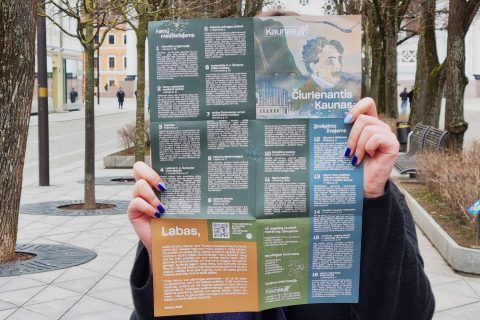“We met at the M. K. Čiurlionis National Museum of Art. We both worked as guides. Since I am an illustrator and Aistė is very interested in children’s literature, we found each other easily”, Dalia Bieliūnaitė laughs. With Valentine’s Day approaching we invited her to tell us more about the cute dog of Čiurlionis named Liamoriukas (it was precisely Dalia that I have learned about it from a while ago), and she also invited Aistė Mišinytė to come along.
Although they no longer work in the same museum, they meet often – Dalia likes to visit her friend’s small apartment on Kęstučio Street, because it turns out that Aistė’s son is a very good cook. “And she has so many books! In addition, Aistė helps me with other work. When I was preparing a book about Liudas Truikys and Marijona Rakauskaitė she was, one might say, my editor.” And the reason for our meeting is a little book titled The Artist’s Dog, which is on its way to the bookstores.

“I was in dire need of Aistė because as an illustrator, I cannot write a book and there are so many stories about Čiurlionis. Liamoriukas was described in great detail by his younger sister Jadvyga. Her memories are so kind and engaging,” Dalia assures. She liked to tell the museum visitors about Liamoriukas. After all, it was immortalized in the pictures! For example, the artist gave his artwork Forest to his sister and told her, “Dream it the way I had dreamt it.” And indeed, on the tallest pine tree in the picture you can spot a puppy…
In the gallery of M. K. Čiurlionis, you can look at a somewhat more realistic image of Liamoriukas. The painting St. Roch (1907) that was recently discovered at Kaimelis’ St. Michael the Archangel’s Church is atypical of Čiurlionis’s work, as the artist rarely took on sacred art and oil paint. In painting or sculpture this saint is often accompanied by a dog. He is the patron saint of the sick and is depicted as a weakened and tired traveler, a pilgrim, showing the black wounds of the plague. It is said that the dog saved his life by feeding him. It is believed that this work was commissioned by Jurbarkas’ church. Čiurlionis had found a picture that inspired him and Liamoriukas “agreed” to become a prototype of the dog that was lying next to St. Rorch’s feet. The painting, which turned out to be of insufficient size, “moved” across the Nemunas to a village. What kind of village? The art historian Rasa Žukienė, who comes from that region, figured it out and the painting was finally discovered!
Our Lemoriukas is very human-like; it doesn’t act exactly like an animal but more like a rambunctious child with strange things happening to him
Aistė pulls out the book Memories about M.K. Čiurlionis, “Liamoriukas was amazing. A character that left a great impression on Jadvyga, a little girl at the time.” Dalia and Aistė both tell a story about how Čiurlionis family got Lemoriukas. There was this Markevičius family, and their son bought a puppy at the market and named it Liamsė (from the French word meaning “friend”) and gave it to the Čiurlionis family. Liamsė gave birth to two puppies, one of them being Liamoriukas. The whole large family (9 children!) voted for the name reminiscent of love and Paris. Liamsė disappeared somewhere, one of her puppies was given to someone and Liamoriukas remained and when Čiurlionis returned home, the dog would be stuck to him. Liamoriukas was a very good dog, it protected cats. If a hostile neighbour’s dog came, Liamoriukas barked until the cats had time to climb the tree. And he would crouch under the tree until it was safe, and the cats could come down. A true gentleman! He would even wait until they ate and only then would he start eating himself. Obviously, the name really suited him. “Yes, the name reflects the character, which is why we are so curious to explore it. We read that when Čiurlionis came home, Liamoriukas, being a small dog, tried to jump up and lick the artist’s face and wouldn’t calm down until he did that. All that was left was for Čiurlionis is to take him in his arms,” Aistė smiles.

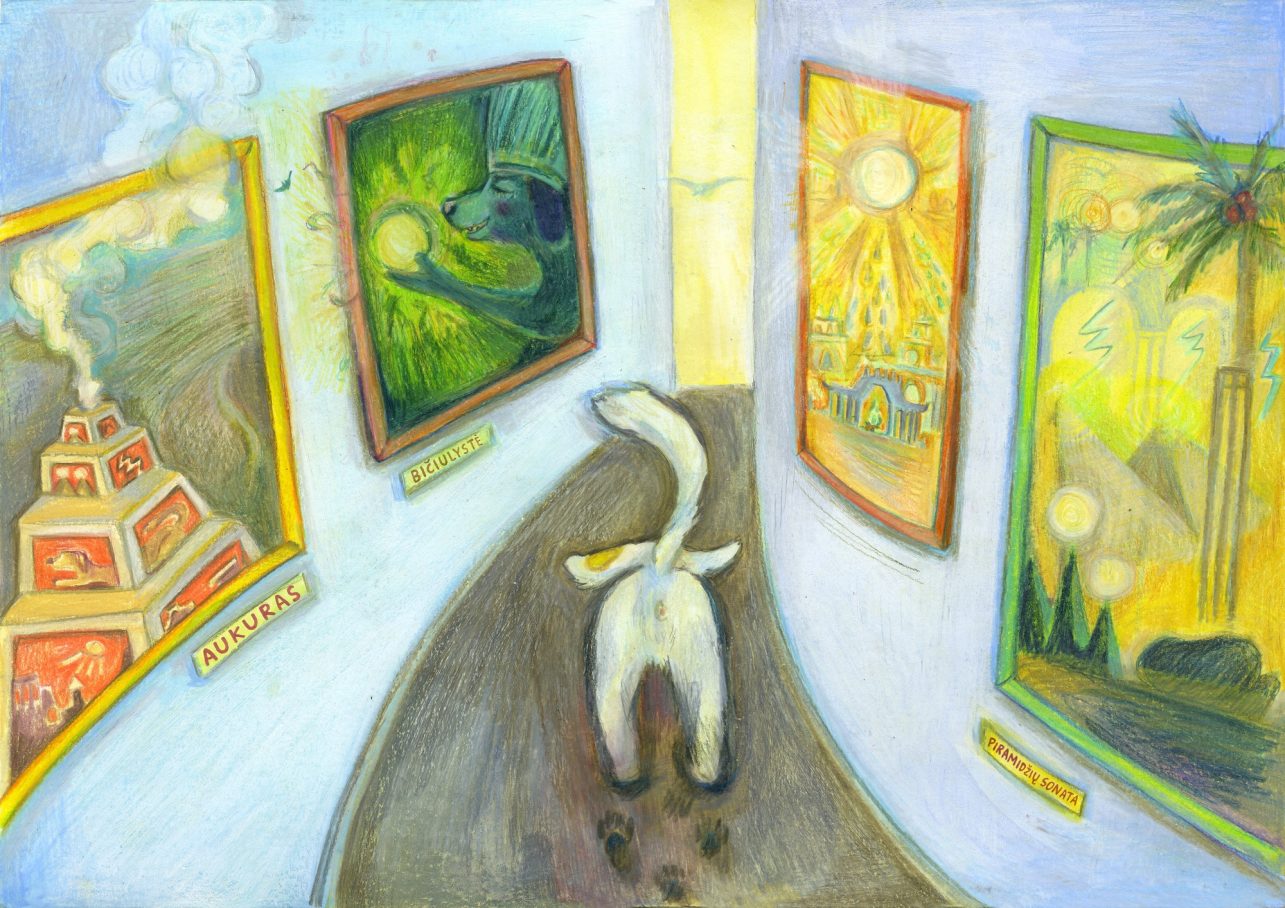
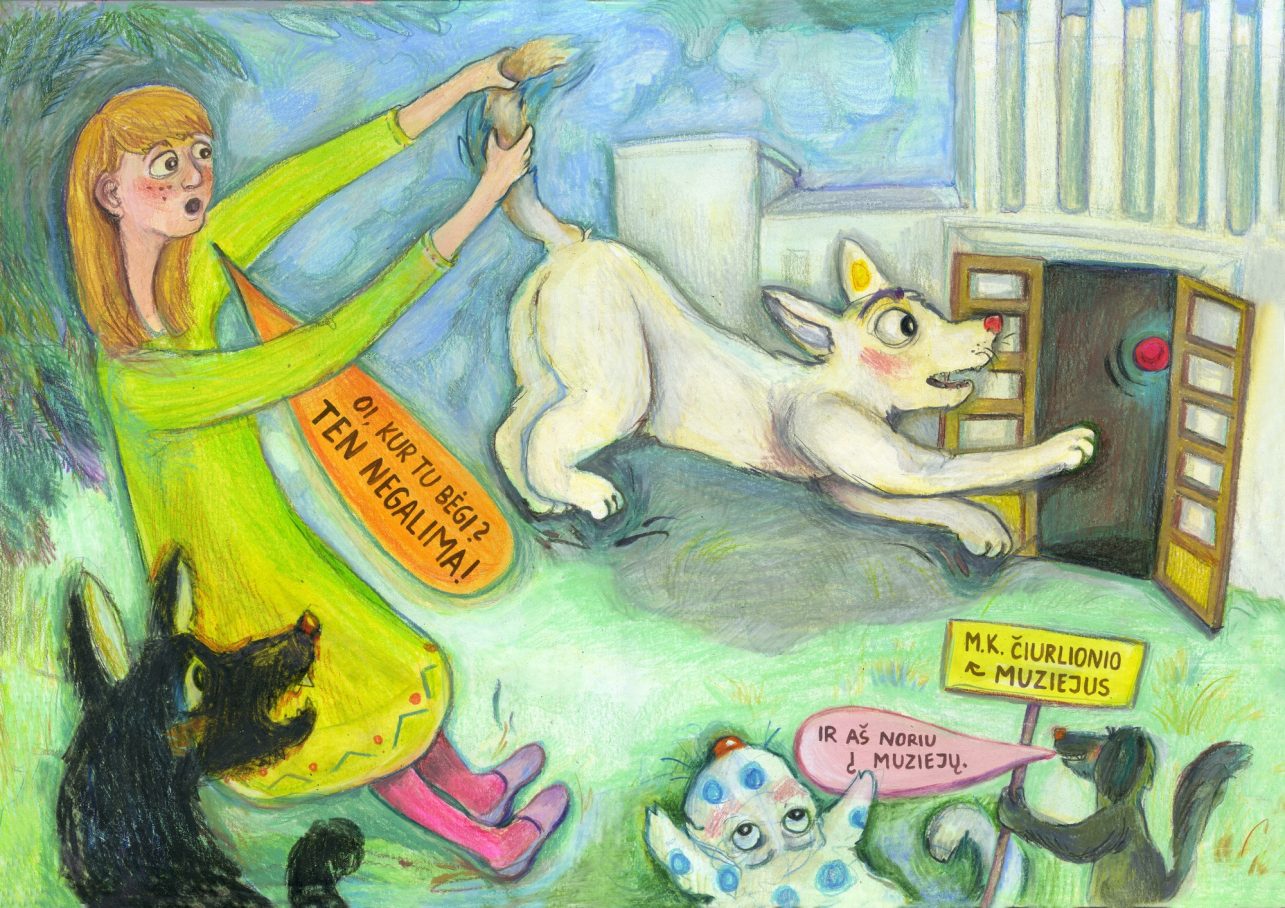
I wonder how long the dog lived but there is simply no such information. Maybe the descendants of Liamoriukas still run around in Druskininkai today. Who could deny it? There are no photos either – only the aforementioned realistic painting of St. Roch and a rather detailed description of Jadvyga, “A light-haired – almost white – dog with a yellow patch on its ear.” The writer was friends with Kazys Boruta, and he has also written a biographical short story about the Čiurlionis family, so one could look for information there as well.
Although my interviewees really like what Jadvyga wrote, you won’t find the full detailed story of Liamoriukas in the upcoming book because it is intended for the smallest, preschool-aged children. It is written to get children interested in Čiurlionis’ paintings and the gallery. The plot is as follows: a dog sneaks into the gallery and runs past the paintings getting into various adventures. How could one not want to follow it? The idea has been developed for several years and the illustrations even made it to the finale of the 55th Bologna Children’s Book Fair in 2021! Dalia redrew everything several times: “When you do such a big job, you grow along with it and keep noticing that you feel like drawing it differently…” The women work in different ways: they meet (for example, in the aforementioned flat on Kęstučio Street), discuss, then each does her part, share the results and observations, “We correspond with each other.”
Dalia says that drawing animals is fun, maybe even the most fun of all. “Animals are gentler, more loving. Since they don’t talk, you need more physical contact with them. This means you generate a lot of warmth. The process is really pleasurable and even therapeutic, which is why I like it. I create my illustrations for this book with colored pencils. It is a medium that you have to press. A lot of physical work. Overall, this book is a therapeutic process.” And I ask Aistė if it’s easier or more difficult for her to write about animals than about people. “Well, our Lemoriukas is very human-like; it doesn’t act exactly like an animal but more like a rambunctious child with strange things happening to him, and with whom the little reader can relate.”
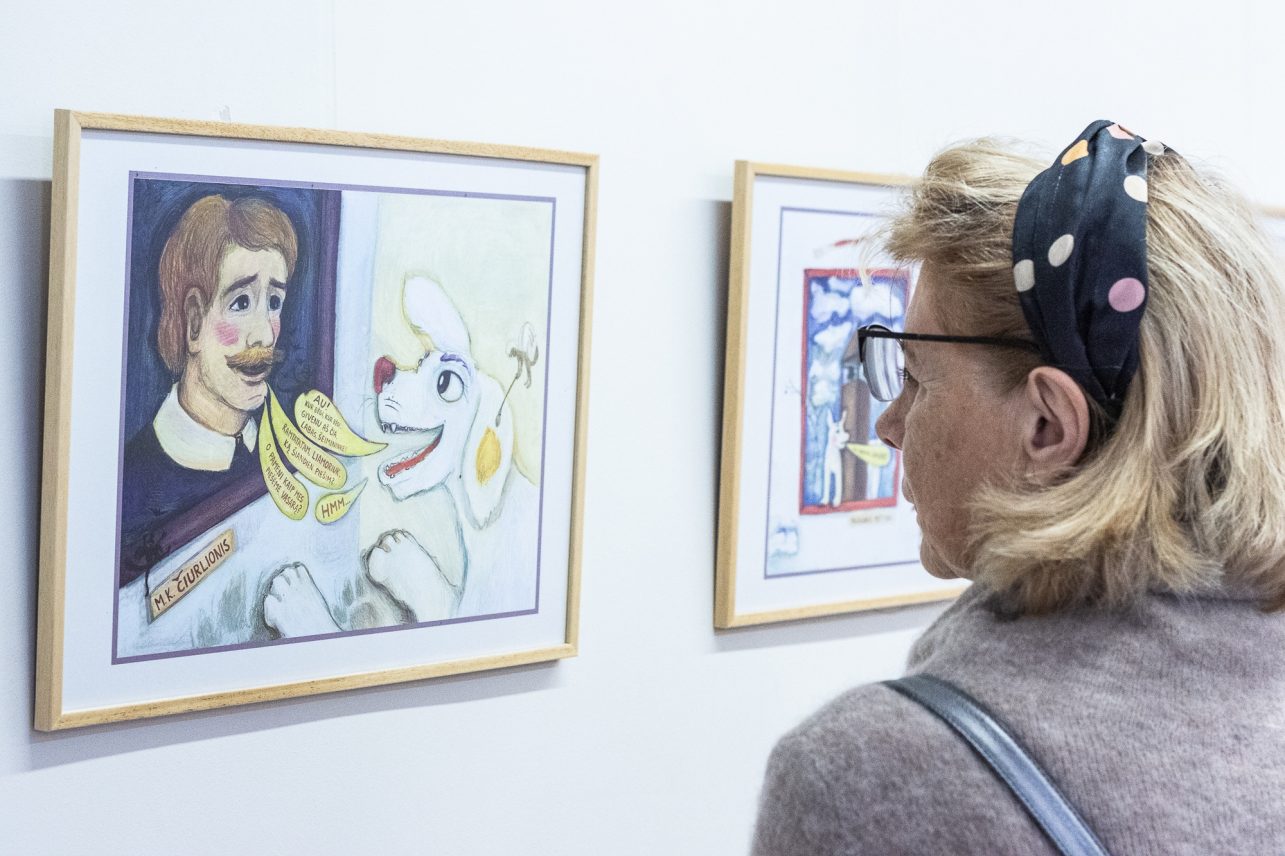
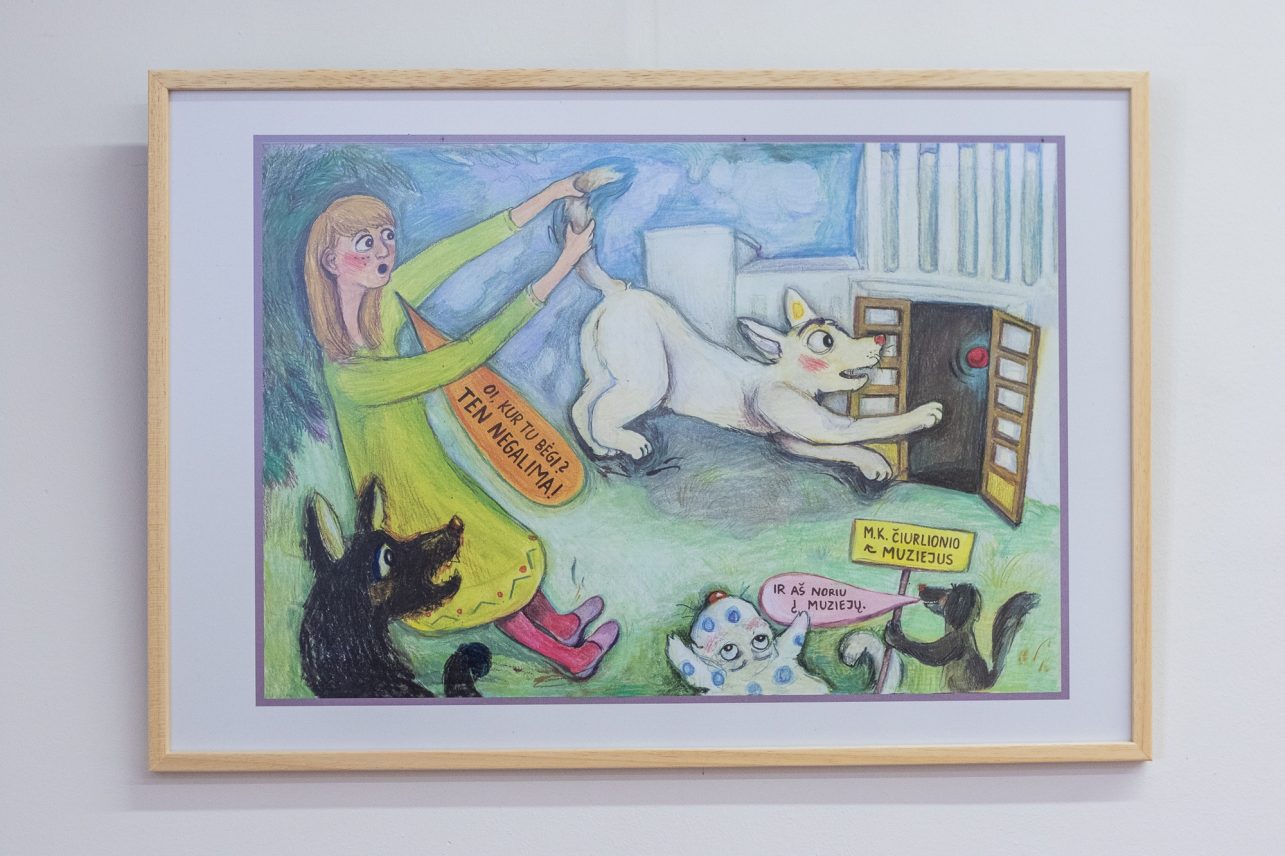
While the Painter’s Dog is slowly materializing, Liamoriukas appeared in another form. The advent book campaign was again organized by VšĮ Vaiko psichologijos centras. After registering, books created by various Lithuanian children’s writers and illustrators arrived at the post office. Children had to print them out and fold them by themselves. Among these advent gifts was a book called Liamoriukas in Winter. And what is this dog like in the cold season? Very loyal and patient, even though his paws are cold, he waits for his beloved master to finish painting.
“Our task is not to provide accurate historical data. There is no record of Čiurlionis painting in Druskininkai in winter, but the children don’t care about that. We want them to get immersed in the atmosphere and simply hear about this artist,” Aistė says. Speaking about the Artist’s Dog, she adds that such a first acquaintance becomes a steppingstone for a growing child. They can step on it and recognize more things and continue to learn. “This principle is applied in many educational books, even for young programmers, for example, who are attracted by the Penguin symbolizing the Linux operating system. We wanted to do exactly the same with art so that the child feels safe and fun in this environment.” Dalia adds that an adult reader easily distinguishes between what is real and what is made up. “After all, everyone knows that dogs are not allowed in the Čiurlionis Gallery,” the illustrator laughs. She is convinced that reading a book about art is a family activity, so the real history of art as a starting point is very important here. It is the parents who are mostly interested in it. And why not look at the things one already knows from another, for example, a dog’s point of view? Then we can see the already familiar pictures in a new light.
During the conversation, we look at Dalia’s sketches, drawings, and the “doll” of the book, which catches the attention of a man sitting next to us in a cafe. He would like to look at the pencil-drawn illustrations and asks whether he could buy one. Dalia gives him her contact information: who knows how this story will end? You see, Liamoriukas is indeed a special animal.
At least Čiurlionis found Liamoriukas the sweetest. But also, you will find many more beautiful stories about artists, the learned, and their pets in Kaunas. Even in sculpture, Vaižgantas is depicted with his dachshund Kaukas, and yellow canaries are also kept in his apartment museum in his honor. You will see what Juozas Grušas’ dog looked like as soon as you enter the playwright’s house. And the greatest artist of all in this field was perhaps Bitė, St. Bernard that knew how to ride a trolleybus and shop in a farmer’s market. She would definitely have gotten along with Liamoriukas because she was also famous for her kindness: she had saved several children once. But that is already another story from Žaliakalnis.


